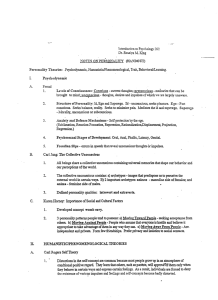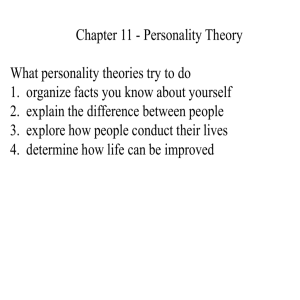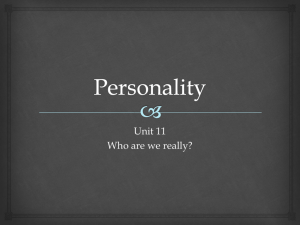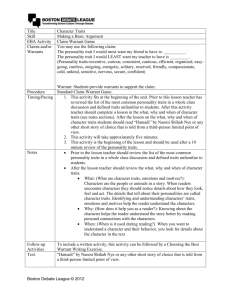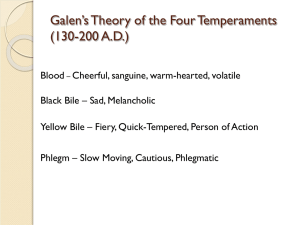Chapter 14
advertisement
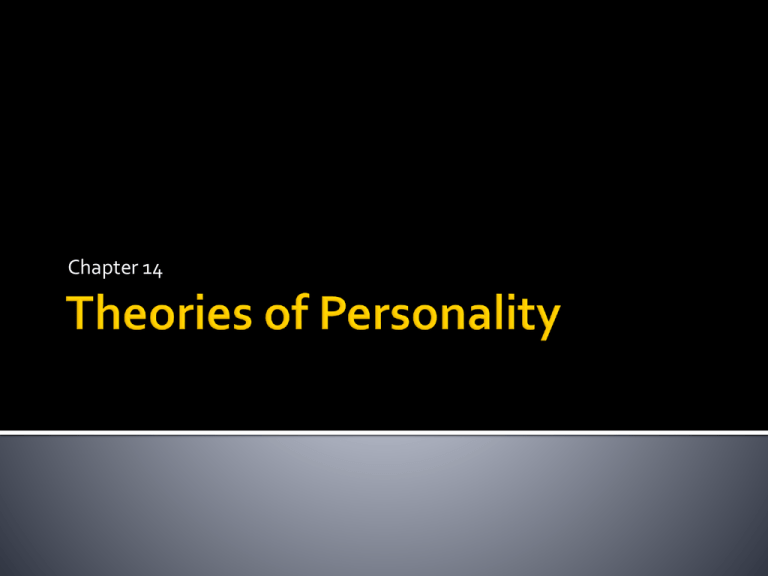
Chapter 14 Personality-the consistent, enduring, and unique, characteristics of a person. First Purpose: To provide a way of organizing the many characteristics you know about yourself and other people. ▪ Ex. Outgoing or shy, quick tempered or calm, witty or dull. Second Purpose: To explain the difference among individuals Third Purpose: Explore how people conduct their lives Fourth Purpose: Determine how life can be improved Sigmund Freud A neurologist who specialized in nervous disorders. Suggested that everyone has a large unconscious Unconscious-the part of the mind that contains material of which we are unaware but that strongly influences conscious processes and behaviors. Id: the part of the unconscious personality that contains our needs, drives, instincts, and repressed material. Ex. When you are born all of your energy is invested in the Id, responding unconsciously to inborn instinctive urges for food and water. ▪ Cookie monster on Sesame Street is pure id. http://www.youtube.com/watch?v=shbgRy ColvE Ego: the part of the personality that is in touch with reality and strives to meet the demands of the id and the superego in socially acceptable ways. Forms during the second and third years of life ▪ If a person is hungry the ego would recognize that the body needs real food and that it will continue to need food in the future. Superego: the part of the personality that is the source of conscience and counteracts the socially undesirable impulses of the id. The moral part of the personality, the source of conscience and of high ideals that operates in terms of moral principle. The id represents what the person wants to do, the ego plans what she can do, and the superego advocates what she should do. Certain specific means by which the ego unconsciously protects itself against unpleasant impulses or circumstances. Rationalization Repression Denial Projection Reaction Formation Regression Displacement Sublimation Get into groups of three or four people Each group will be assigned a defense mechanism Write out a skit illustrating the defense mechanism in action. You will present your skit to the class. After each group presents we will discuss as a group the positive and negative effects of the defense mechanism for the characters involved. EVERYONE MUST PARTICIPATE!!! Freud’s associate Disagreed with Freud on two points Jung ( Young) took a positive view of human nature, people develop their potential as well as handle their instinctual urges. Introduced analytic psychology ( mysticism and religion play a major role) He also distinguished between the personal unconscious and the collective unconscious. Collective unconscious- primitive concepts called archetypes. The part of the mind that contains inherited instincts , urges, and memories common to all people. Ex: evil witch, young hero, nurturing mother. All cultures have these archetypes. Every person conscious sense of self integrates four functionsthinking, feeling, intuition, and sensation. He called the integrating process individuation. Believed that the diving force in people’s lives is a desire to overcome their feelings of inferiority. Everyone struggles with inferiority according to Adler. Inferiority complex- a pattern of avoiding feelings of inadequacy rather than trying to overcome their source. Erich Fromm- theory centered around the need to belong and the loneliness that freedom can bring. Karen Horney-stressed the importance of basic anxiety, which a child feels because she is helpless, and basic hostility, a resentment of one’s parents that generally accompanies this anxiety Erik Erikson- outlined eight psychosocial stages that every person goes through from birth to old age and that describe the importance of interacting with others. A trait is an aspect of personality that is reasonably stable. Main features of the trait approach states that traits are consistent and unchanging. Hippocrates: Greek physician believed that traits came from biological combinations of body fluids. Gordon Allport: 1930’s described traits as physical, behavioral, and inherited. Combination of traits dictates a person’s personality. Hans Eysenck: focused on two dimensions of personality Extroversion vs. Introversion and emotional stability-instability. Trait-a tendency to react to a situation in a way that remains stable over time. Ex. Nice, smart, and arrogant. Trait theorists make two basic assumptions Every trait applies to all people These descriptions can be quantified ▪ Establishing a scale on which an extremely dependent person scores 1 while a very independent person scores 10. Allport defined common traits as those that apply to everyone and individual traits as those that apply more to a specific person. Three kinds of individual traits Cardinal trait-a characteristic or feature that is so enveloping the person is almost identified with it Central trait-makes us predictable in most situations Secondary trait-least important and have less consistent influence Surface traits- a stable characteristic that can be observed in certain situations He came up with 46 surface traits. Then he came up with 16 source traits Source trait- a stable characteristic that can be considered to be at the core of personality. He believed that measuring those traits, psychologists could predict people’s behavior in certain situations. Extroverts: are sociable, outgoing, active, lively people. They enjoy parties and seek excitement. Introverts: more thoughtful, reserved, passive, unsociable, and quiet. Five traits appear repeatedly in different research studies. OCEAN Openness – (inventive/curious vs. consistent/cautious). Appreciation for art, emotion, adventure, unusual ideas, curiosity, and variety of experience. Conscientiousness – (efficient/organized vs. easy-going/careless). A tendency to show selfdiscipline, act dutifully, and aim for achievement; planned rather than spontaneous behavior. Extraversion – (outgoing/energetic vs. solitary/reserved). Energy, positive emotions, and the tendency to seek stimulation in the company of others. Agreeableness – (friendly/compassionate vs. cold/unkind). A tendency to be compassionate and cooperative rather than suspicious and antagonistic towards others. Neuroticism – (sensitive/nervous vs. secure/confident). A tendency to experience unpleasant emotions easily, such as anger, anxiety, depression, or vulnerability. Work in pairs to complete your study guide. http://www.youtube.com/watch?v=WsAShp M_jyM&feature=related http://www.youtube.com/watch?v=rbEGSDIk sxs&feature=related
